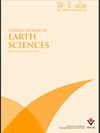Hydrogeochemical pattern and environmental isotope hydrology of coastal Bademli geothermal area (BGA) in western Turkey (Dikili-İzmir): A new geothermal prospect
IF 1.1
4区 地球科学
Q3 GEOSCIENCES, MULTIDISCIPLINARY
引用次数: 1
Abstract
: Bademli geothermal area (BGA) is located on the coastline of Dikili-İzmir province and consists of Bademli spring and Hayıtlı areas with 36.8–51°C discharge temperatures, respectively. The waters of Hayıtlı borehole have remarkable seawater mixing ratios like Bademli spring and have Na-Cl water type. Dikili group pyroclastic volcanic units constitute the reservoir rock in the entire geothermal area. The heat source is relatively elevated geothermal gradient caused by extensional tectonics forming E-W trending grabens. Bademli thermal water is plotted in the “immature waters” area in the Na-K-Mg triangular diagram with a calculated seawater contribution of 18%. Therefore, some cation geothermometers are considered unreliable. On the other hand, the silica-enthalpy diagram showed an anticipated reservoir temperature of approximately 240 °C. Hayıtlı borehole water sample is plotted on the “partially equilibrated waters” area in the same triangular diagram and shows a reservoir temperature of 208 °C. The seawater contribution in the Hayıtlı area (16%) is less than the Bademli spring. On the other hand, based on the K/Mg geothermometry, the reservoir temperatures for Bademli spring and Hayıtlı borehole waters are 129 °C and 138 °C, respectively. B, Fe, Mn, and Sb concentrations exceed the tolerance limits of the EPA and Turkish drinking water standards in the area. In addition, due to silica-rich volcanic rocks, Ge solubility increased with temperature in thermal waters and reached 34–45 µg/L. Enrichment of δ 18 O and δ 2 D values can be observed in Bademli spring and Hayıtlı with –3.70‰ and –4.63‰, and –34.5‰ and –37.9‰, respectively. From the chemical and isotopic results, it can be clearly said that this coastal geothermal area is high enthalpy, as evident from the equilibrium temperatures. However, when the thermal water rises to the surface, it mixes with both cold groundwater and modern seawater resulting in a decrease of the discharge temperatures of the springs. Moreover, according to the isotopic and hydrogeochemical data, the area has a high potential for thermal heating of the settlements in the area.土耳其西部沿海Bademli热区(Dikili-İzmir)水文地球化学模式和环境同位素水文:一个新的地热前景
巴德姆利地热区(Bademli geothermal area, BGA)位于迪基利省-İzmir的海岸线上,由巴德姆利温泉区和Hayıtlı区组成,泄温分别为36.8 ~ 51℃。Hayıtlı钻孔水体与Bademli泉的海水混合比显著,为Na-Cl水型。底基利群火山碎屑火山单元构成了整个地热区的储集岩。热源为伸展构造形成东西向地堑所引起的地温梯度相对升高。Bademli热水被绘制在Na-K-Mg三角形图中的“未成熟水”区域,计算出的海水贡献为18%。因此,一些阳离子地温计被认为是不可靠的。另一方面,硅热焓图显示,预计储层温度约为240℃。Hayıtlı钻孔水样在同一三角形图的“部分平衡水”区域上绘制,显示储层温度为208°C。Hayıtlı地区的海水贡献率为16%,低于巴德姆里泉。另一方面,根据K/Mg地热测量,巴德姆里泉和Hayıtlı井水的储层温度分别为129℃和138℃。B、Fe、Mn和Sb的浓度超过了该地区EPA和土耳其饮用水标准的容忍限度。此外,由于火山岩富含硅,Ge在热水中的溶解度随温度升高而升高,达到34 ~ 45µg/L。巴德姆里泉和Hayıtlı的δ 18o和δ 2 D值富集,分别为-3.70‰和-4.63‰,-34.5‰和-37.9‰。从化学和同位素结果可以清楚地说,这个沿海地热区是高焓的,从平衡温度可以看出。然而,当热水上升到地表时,它与冷地下水和现代海水混合,导致温泉的排放温度降低。此外,根据同位素和水文地球化学资料,该地区具有较高的聚落热加热潜力。
本文章由计算机程序翻译,如有差异,请以英文原文为准。
求助全文
约1分钟内获得全文
求助全文
来源期刊

Turkish Journal of Earth Sciences
地学-地球科学综合
CiteScore
2.40
自引率
10.00%
发文量
6
审稿时长
6 months
期刊介绍:
The Turkish Journal of Earth Sciences is published electronically 6 times a year by the Scientific and Technological Research
Council of Turkey (TÜBİTAK). It is an international English-language journal for the publication of significant original recent
research in a wide spectrum of topics in the earth sciences, such as geology, structural geology, tectonics, sedimentology,
geochemistry, geochronology, paleontology, igneous and metamorphic petrology, mineralogy, biostratigraphy, geophysics,
geomorphology, paleoecology and oceanography, and mineral deposits. Contribution is open to researchers of all nationalities.
 求助内容:
求助内容: 应助结果提醒方式:
应助结果提醒方式:


